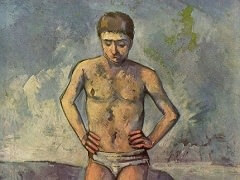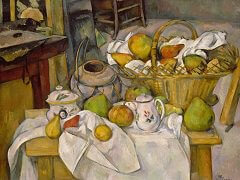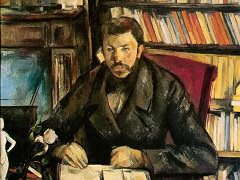Chestnut Trees at the Jas de Bouffan, 1885 by Paul Cezanne

The effect of a noble calm in Cezanne's painting does not require an obvious dominance of horizontals and bare geometric forms. There is a similar quality in this painting with many repeated verticals and intricate branching lines. Its repose is an outcome of more delicate relationships in the colors and forms. What is architectural in the conception reminds us of mediaeval rather than classic buildings, although it is so tranquil and relaxed. Cezanne has re-discovered here a principle of Moslem art: complicated ornamental lines, lacy and elusive, set above sparser, stable forms. In the late Gothic, too, the spreading ribs of the vaults often rise from simple piers. Cezanne, however, has chosen a viewpoint with a minimum of perspective play and hence little tension in depth. The side wall of the building at the left seems to face viewers like the front wall. The peak of the distant mountain, which might be a focus of the scene, is hidden by two trees. Cezanne places himself far off to the left, but sees the two rows of trees as an openwork screen parallel to the picture plane, like the stone wall and the low horizon. The separateness of things, their simple alignment in space, with only slight diagonal movements in depth, adds to the prevailing calm. The tree trunks, gently varied in thickness, tilt, branching, interval, and illumination, are unique organic shapes, firm but without the rigidity and strain of pure columnar forms. The upward striving force of the vertical lines is gradually dissipated in the all-over network of thinner, lighter branches which are finally lost in the vaporous sky. These graceful branching forms are beautifully designed, without a dull repeat. They arise imperceptibly from the heavier limbs and merge with the drawn outlines of the buildings and smaller trees. Their diagonal movements also parallel the sloping edges of the muted mountain peak.
We must not ignore, however, the importance of the horizontal in this work in which horizontal elements are so few and are broken by the stronger vertical forms. At the base of the whole is the broad band of green, a subtly painted carpet of many tones opposed to the greyed violet and brown of the vertical trees - a contrast of color that re-enforces the contrast of supporting and supported forms and is more striking still through the difference in brush stroke on the ground and trees. Behind are intermittent horizontal bands of yellow and lighter green, followed by the stone wall and the house which together repeat the alternation of the light and shadow tones in the trees. The succession of bands of varied color and stroke, with a progressive lightening of both color and touch, creates in the lower half of the space a grid of horizontal and vertical lines, which is gradually transformed into the diagonal network above through the sloping forms of the roofs, the hillside, and the distant peak.














